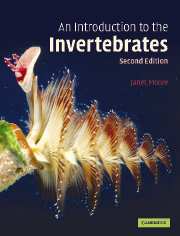Book contents
- Frontmatter
- Contents
- List of boxes
- Preface
- Acknowledgements
- Illustration acknowledgements
- Chapter 1 The process of evolution: natural selection
- Chapter 2 The pattern of evolution: methods of investigation
- Chapter 3 Porifera
- Chapter 4 Cnidaria
- Chapter 5 On being a worm
- Chapter 6 Platyhelminthes and Acoelomorpha
- Chapter 7 Nemertea
- Chapter 8 Nematoda
- Chapter 9 Annelida
- Chapter 10 Mollusca: general and Gastropoda
- Chapter 11 Mollusca: Bivalvia and Cephalopoda
- Chapter 12 Arthropoda: general
- Chapter 13 Crustacea
- Chapter 14 Chelicerata and Myriapoda
- Chapter 15 Insecta
- Chapter 16 Animals with lophophores
- Chapter 17 Echinodermata
- Chapter 18 Invertebrate Chordata and Hemichordata
- Chapter 19 Development
- Chapter 20 Invertebrate evolutionary history
- Further reading
- Glossary
- Index
Chapter 3 - Porifera
Published online by Cambridge University Press: 05 September 2012
- Frontmatter
- Contents
- List of boxes
- Preface
- Acknowledgements
- Illustration acknowledgements
- Chapter 1 The process of evolution: natural selection
- Chapter 2 The pattern of evolution: methods of investigation
- Chapter 3 Porifera
- Chapter 4 Cnidaria
- Chapter 5 On being a worm
- Chapter 6 Platyhelminthes and Acoelomorpha
- Chapter 7 Nemertea
- Chapter 8 Nematoda
- Chapter 9 Annelida
- Chapter 10 Mollusca: general and Gastropoda
- Chapter 11 Mollusca: Bivalvia and Cephalopoda
- Chapter 12 Arthropoda: general
- Chapter 13 Crustacea
- Chapter 14 Chelicerata and Myriapoda
- Chapter 15 Insecta
- Chapter 16 Animals with lophophores
- Chapter 17 Echinodermata
- Chapter 18 Invertebrate Chordata and Hemichordata
- Chapter 19 Development
- Chapter 20 Invertebrate evolutionary history
- Further reading
- Glossary
- Index
Summary
Sponges are by far the simplest multicellular animals and are very different from all the others. They have no fixed body shape, no plane of symmetry and are covered in holes. All sponges live in water, nearly all in the sea. The cells are uncoordinated, cell differentiation is entirely reversible and cells may wander about in the background jelly. A whole sponge can be regenerated from a few separated cells. Sponges can almost be regarded not as individuals but as colonies of separate cells; almost but not quite, as most have a skeleton made of spicules that supports the body.
These very simple animals are nonetheless very successful and widespread: since the early Cambrian they have covered most of the suitable surfaces on the shore and in the shallow sea: the latest survey found 15 000 living species. How is it that such simple animals can do so well? What has there been for natural selection to work on in this phylum? How fundamentally do they differ from other animals and what are their evolutionary and ecological relationships with them? To address these questions, we must study the basic structure and the different kinds of sponges, and indicate the ways in which they make a living.
What are the distinguishing characters of sponges?
Sponges are sessile and immobile, having neither nerves nor muscles. There may be slight contractility round the larger pores but it is very restricted.
Sponge cell types are the distinctive collar cells or ‘choanocytes’ (Figure 3.1a), the ‘pinacocytes’ that make an outer layer and the ‘amoebocytes’ wandering through the central jelly or ‘mesohyl’. This jelly is needed for support; in contrast to other animals, neighbouring cells are not bound together by a basement membrane.
[…]
- Type
- Chapter
- Information
- An Introduction to the Invertebrates , pp. 23 - 31Publisher: Cambridge University PressPrint publication year: 2006



